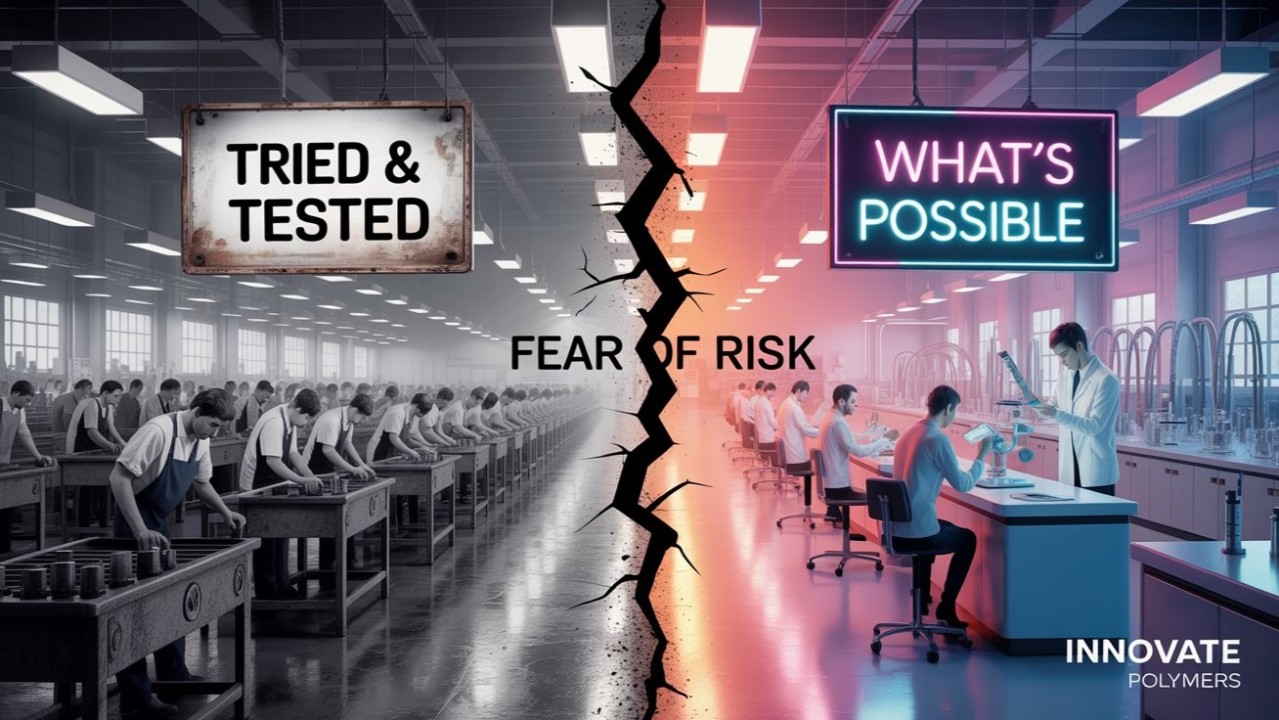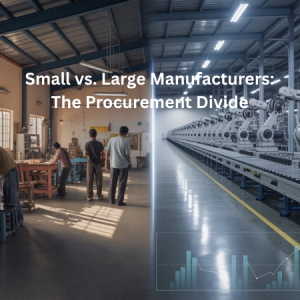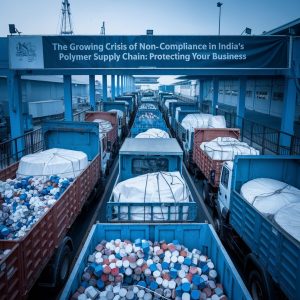

Copy-Paste vs. Innovation
Published on: June 18, 2025
Author: Team JITSY
Why Indian Manufacturing Avoids R&D - and Why That Might Be the Riskiest Strategy of All
Is playing it safe actually the riskiest strategy? The uncomfortable truth about innovation avoidance in Indian manufacturing
Ravi's factory is running at full capacity. Orders flowing, machines humming, his team executing processes they've mastered over years. Then the phone rings.
"Can you make UV-resistant PVC pipes for high-altitude installations? We need them for a solar project in Ladakh."
Pause. The kind of pause that speaks volumes.
"We haven't done that specific application before. Let me get back to you."
Ravi checks with his masterbatch supplier, consults his process engineer, runs the numbers in his head. New additives, test batches, probably a week of production downtime, uncertain outcomes.
"Not worth the trouble," he decides, and refers the customer to a Chinese supplier who specialises in such applications.
This conversation happens every day across Indian manufacturing—from Ludhiana's textile mills to Coimbatore's pump manufacturers. Factories run on muscle memory, not curiosity. When faced with the unknown, the default response isn't "Let's figure this out" but "Why complicate things?"
But here's the uncomfortable question we need to ask: Is playing it safe actually the riskiest strategy of all?
The JITSY Insight: Innovation Avoidance Is the New Risk
At JITSY, we interact with hundreds of manufacturers across polymer processing, packaging, automotive components, and industrial applications. What we've observed is a fascinating paradox: companies that think they're minimising risk by avoiding R&D are actually maximising their long-term vulnerability.
The manufacturers thriving today aren't necessarily the ones with the biggest factories or the cheapest prices—they're the ones who can solve problems others can't. Yet most Indian manufacturers seem allergic to the very thing that could differentiate them: innovation.
Why does this matter so much right now?
Global supply chains are fragmenting. Customers are demanding more customised solutions. Regulations are tightening around sustainability and performance standards. Raw material compositions are evolving rapidly. In this environment, the ability to adapt and innovate isn't a luxury—it's survival insurance.
The Psychology Behind Innovation Avoidance
Let's dig deeper into why Indian manufacturers, despite their incredible operational capabilities, shy away from R&D:
1. R&D Feels Like Gambling with Thin Margins
"Boss, margins are already at 8%. Why spend money on experiments that might not work?"
This logic seems sound until you realize that thin margins are often the result of having no differentiation. When your only competitive advantage is price, you're trapped in a race to the bottom.
We've seen this pattern repeatedly: manufacturers who avoid R&D because margins are tight, only to find margins getting tighter because they have nothing unique to offer. It's a vicious cycle that innovation breaks.
The Real Question: Is the cost of R&D higher than the cost of remaining a commodity supplier forever?
2. The Jugaad Trap: When Shortcuts Become Ceilings
India's jugaad mentality is legendary—and for good reason. The ability to find quick, resourceful solutions to immediate problems has built countless successful businesses. But there's a difference between jugaad and systematic innovation.
Jugaad says: "How can we make this work with what we have?" R&D asks: "How can we make this work better than anyone else?"
A packaging manufacturer in Gujarat told us: "We've been jugaading our way through customer requirements for 15 years. But now we're hitting problems that jugaad can't solve. Customers want food-grade barriers we've never made, recycled content percentages we've never achieved. Suddenly, we need real technical knowledge, not just clever workarounds."
The Hidden Cost: Jugaad solves today's problem but doesn't build tomorrow's capability.
3. The Copy-Paste Comfort Zone
"Why reinvent when we can reverse-engineer?"
In polymer processing, formulations seem readily available. A competitor's successful product can be analysed, an ex-employee knows the recipe, a consultant can "match" the specs. So why invest in original development?
Here's what we've learned from our supplier network: copying gives you yesterday's solution to today's problem. But what happens when tomorrow brings a completely new challenge?
A Real Example: A pipe manufacturer in Rajasthan built their entire product line by reverse-engineering competitors' formulations. When new BIS standards required specific performance characteristics that weren't just about material composition but also about processing parameters, they were stuck. They could copy the recipe but not the process knowledge that made it work consistently.
4. The Ecosystem Gap: Where's the Support System?
Unlike IT or pharmaceuticals, manufacturing R&D often feels lonely. Technical consultants are expensive and hard to find. Testing labs are either inaccessible or prohibitively costly. Government schemes exist but are wrapped in bureaucratic complexity.
One automotive component manufacturer asked us: "We want to develop lighter, stronger parts using new polymer blends. But where do we start? Who helps with material selection? Where do we test prototypes? How do we validate performance?"
The Infrastructure Reality: The support system for manufacturing innovation needs serious upgrades.
The Hidden Costs of Innovation Avoidance
Let's quantify what avoiding R&D actually costs:
Zero Pricing Power
When you're manufacturing the same products as everyone else, price becomes the only differentiator. You're trapped in commodity competition where the lowest bidder wins.
Real Impact: A flexible packaging manufacturer told us their margins dropped from 18% to 11% over three years simply because they couldn't offer anything competitors couldn't match.
Customer Loyalty Erosion
Without unique capabilities, customer relationships are purely transactional. The moment someone offers a better price or a superior product, customers switch.
Pattern We See: Manufacturers losing long-term customers to suppliers who developed specific technical capabilities they couldn't provide.
Import Dependency Growth
When customers need specialized materials or components, Indian manufacturers often end up sourcing from Korea, Taiwan, Germany, or China—losing margin and control in the process.
Supply Chain Reality: A medical device manufacturer spends 23% more on imported polymer grades because local suppliers haven't developed the required technical capabilities.
No Legacy Building
You're running a business, not building a brand. Without intellectual property or unique capabilities, there's nothing defensible about your market position.
Why This Matters More Than Ever
Several trends are making innovation avoidance increasingly risky:
Regulatory Acceleration: Environmental standards, safety requirements, and performance specifications are evolving rapidly. Companies that can't adapt their products will be left behind.
Supply Chain Localisation: As global supply chains become more fragmented, customers are looking for local suppliers who can provide technical solutions, not just manufacturing capacity.
Sustainability Pressure: The shift toward recycled content, bio-based materials, and circular economy principles requires innovation capabilities, not just production scale.
Customisation Demand: B2B customers increasingly want tailored solutions rather than standard products, creating opportunities for technically capable suppliers.
The Chinese Innovation Model: What We Can Learn
China's manufacturing success isn't just about scale—it's about systematic investment in innovation capabilities.
What Chinese Manufacturers Do Differently:
- Allocate 3-8% of revenue to R&D consistently
- Build internal technical teams alongside production teams
- Establish partnerships with universities and research institutes
- Document and systematically improve processes
- Invest in testing and validation capabilities
The Result: Chinese suppliers can often provide customised solutions Indian manufacturers refer to others.
Question Worth Considering: Can India become the "world's manufacturing hub" while remaining primarily an execution center for others' innovations?
Breaking the Innovation Avoidance Cycle
The good news? You don't need massive investments or PhD teams to start building innovation capabilities. Here's how progressive manufacturers are approaching it:
1. Micro-Innovation Strategy
Instead of big R&D projects, try systematic small improvements:
- Modify one formulation parameter every quarter
- Test recycled content in existing products
- Experiment with processing conditions to improve efficiency
- Develop one new grade or application annually
Success Story: A sheet manufacturer in Tamil Nadu started with small modifications to their PVC formulation for better weldability. Three years later, they're the preferred supplier for a major elevator company because of their specialized welding-grade sheets.
2. Supplier Collaboration for Innovation
Your raw material suppliers have extensive application knowledge across industries and regions. Smart manufacturers are leveraging this.
How JITSY Helps: We share insights about what's working in other industries, successful formulations from different regions, and emerging application trends. Why experiment blindly when you can build on proven knowledge?
3. Customer-Driven Innovation
Turn customer complaints and requests into innovation opportunities:
- Track recurring quality issues and systematically solve them
- Ask customers about unmet needs in their applications
- Understand why they might choose imported alternatives
- Develop solutions for their future challenges, not just current ones
Real Example: A pipe manufacturer started tracking customer feedback about installation difficulties. They developed a new jointing compound that reduced installation time by 30%, creating a significant competitive advantage.
4. Process Documentation and Improvement
Innovation isn't just about new products—it's about doing existing things better:
- Document what works and what doesn't in each production run
- Systematically test process improvements
- Build institutional knowledge that doesn't depend on individual expertise
- Create feedback loops between production and quality teams
The JITSY Partnership Approach
At JITSY, we want to work with manufacturers who see innovation as opportunity, not overhead. Here's how we support innovation-minded partners:
Technical Knowledge Sharing: Access to application data, successful formulations from other industries, and emerging material trends.
Supplier Network Leverage: Connect with raw material suppliers who can provide technical support for new applications.
Market Intelligence: Understanding what's working in other regions and industries that might apply to your business.
Risk Mitigation: Smaller batch sizes for trials, flexible terms for experimental orders, and access to alternative materials for testing.
Looking Forward: The Innovation Imperative
We're not suggesting every manufacturer needs to become a research laboratory. But the manufacturers who will thrive in the next decade will be those who can solve problems others can't.
Three Levels of Innovation Readiness:
Level 1 - Process Innovation: Consistently improving how you make existing products (quality, efficiency, cost)
Level 2 - Application Innovation: Adapting existing products for new uses or markets
Level 3 - Product Innovation: Developing new products or capabilities that create market differentiation
Most manufacturers should aim for Level 1 and 2, with selective investments in Level 3 based on market opportunities.
The Bottom Line: Why This Matters for Your Future
Immediate Impact: Every customer request you can't fulfill is a growth opportunity lost. Every technical challenge you avoid is a competitive advantage surrendered.
Strategic Implications: As global supply chains evolve and customer demands become more sophisticated, technical capability will increasingly determine market success.
Long-term Positioning: The manufacturers building innovation capabilities today will be the industry leaders tomorrow. Those avoiding it will become increasingly marginalized.
Competitive Reality: Your competitors—both domestic and international—are innovating. Standing still is moving backward.
Questions That Challenge Conventional Thinking
Is your current "risk-averse" strategy actually increasing your long-term risk?
Every avoided innovation opportunity is a bet that your current capabilities will remain relevant indefinitely. How confident are you in that bet?
What would happen if one major customer asked for something you couldn't provide?
If losing a single customer because of technical limitations would significantly impact your business, you might be more vulnerable than you think.
Are you building a business or just running a production facility?
There's a difference between having manufacturing capabilities and having market-differentiating capabilities. Which one describes your business?
What stops you from dedicating 2-3% of revenue to systematic capability building?
If margins are too thin for innovation investment, are they thick enough for long-term survival?
The Challenge to Indian Manufacturing
The future belongs to manufacturers who can solve problems, not just execute processes. The good news? Indian manufacturing has incredible operational excellence. The opportunity? Combining that excellence with systematic innovation capabilities.
At JITSY, we're committed to supporting manufacturers who want to build technical capabilities alongside production capacity. Because the next era of Indian manufacturing won't be built on what we've always done—it'll be built on what we dare to do next.
Ready to explore what innovation could mean for your business?
Connect with us at www.jitsy.in or reach out directly to discuss how your company can start building innovation capabilities without massive upfront investments.
What's stopping your company from investing in innovation? Have you found ways to balance risk and experimentation? What technical challenges are you avoiding that might actually be opportunities? Let's continue this conversation and share insights that can help Indian manufacturing evolvey of All
India’s Polymer & Raw Material Supply Partner for Progressive Manufacturers
The above is not a rare story. It’s a reality we encounter across the Indian manufacturing landscape, from Ludhiana to Coimbatore. Factories, big and small, run on muscle memory, not curiosity. When faced with the unknown, the response isn’t: “Let’s try.” It’s: “Why take the risk?”
But in that hesitation lies the core question we want to explore today:
Is playing it safe actually the riskiest strategy?
We’re ready to partner with you — not just as a supplier, but as a thought collaborator. Let’s build the next era of Indian manufacturing — not on what we’ve always done, but on what we dare to do next.
About JITSY JITSY is India’s most trusted partner for polymers and allied raw materials — from PVC and EVA to engineering plastics. We don’t just supply. We support our clients with quality assurance, application know-how, and future-ready insights.
📩 Let’s talk: connect@jitsy.in 🌐 Explore: www.jitsy.in
Latest Articles

Small vs. Large Manufacturers: The Procurement Divide That’s Holding India Back
India cannot afford to grow unequally. If the vision is to become a global manufacturing powerhouse, we must ensure that procurement works for everyone – not just the big players.

The Great Procurement Divide: Why Your Best Engineers Make Your Worst Buyers
“He knows everything about polymers—so let him handle the purchase too.”

Copy-Paste vs. Innovation
Is playing it safe actually the riskiest strategy? The uncomfortable truth about innovation avoidance in Indian manufacturing

The Credit Cycle Shift: Why 30-Day Payments Are Winning Hearts (and Wallets)
The Credit Cycle Shift: Why 30-Day Payments Are Winning Hearts (and Wallets)

The Great Inventory Debate
Just-in-Time vs. Just-in-Case After COVID

The 0.1% That Destroys the 99.9%: Why Documentation in B2B Trade Isn’t Optional Anymore
“Sir, you have my word.”
“It’s done. Dispatch tomorrow.”

The Growing Crisis of Non-Compliance in India’s Polymer Supply Chain: Protecting Your Business
The Hidden Danger in Your Raw Material Procurement. Manufacturing sectors face increased scrutiny…

Complete Documentation Isn’t Optional – It’s Critical
Six months later, you receive a notice from the GST department that sends a chill down your spine…

5 Ways to Optimise Your Polymer Supply Chain
Explore five proven approaches that can transform your polymer supply chain…
Experience seamless supply chain solutions with JITSY. Your trusted partner for Just in Time Supply needs. Optimise operations today!
Quick Links
Contact
- connect@jitsy.in
- +91 9711562699
-
Salcon Rasvilas
Saket, New Delhi
India






